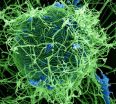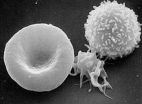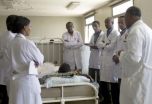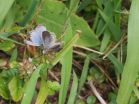(Press-News.org) Alexandria, Va. — The La Brea tar pits in downtown Los Angeles are a famous predator trap. For every herbivore, a dozen or more carnivores — saber-toothed cats and dire wolves chief among them — are pulled from the prolific Pleistocene fossil site. In fact, the remains of more than 4,000 dire wolves have been excavated, along with more than 2,000 saber-toothed cats. The sheer number of fossils allows researchers to ask population-level questions about the climate and environment as well as how these animals evolved.
Now, two new studies focusing dire wolves and saber-toothed cats are characterizing how the tar pits' two top predators coped with the warming climate toward the end of the last ice age, and the results are surprisingly dissimilar: While the wolves got smaller, the cats got bigger.
Read more about how the predators' physiologies adapted to changing climatic conditions in the August issue of EARTH Magazine: http://bit.ly/1sZ1KJQ.
For more stories about the science of our planet, check out EARTH magazine online or subscribe athttp://www.earthmagazine.org. The August issue, now available on the digital newsstand, features stories about a new fossil dino dubbed the "chicken from hell" found in North and South Dakota's Hell Creek Formation, how people's perceptions of earthquake motion can depend on their motion, and the first direct evidence of water in the mantle's transition zone, plus much, much more.
INFORMATION:
Keep up to date with the latest happenings in Earth, energy and environment news with EARTH magazine online at:http://www.earthmagazine.org/. Published by the American Geosciences Institute, EARTH is your source for the science behind the headlines.
The American Geosciences Institute is a nonprofit federation of 49 geoscientific and professional associations that represents more than 250,000 geologists, geophysicists and other earth scientists. Founded in 1948, AGI provides information services to geoscientists, serves as a voice of shared interests in the profession, plays a major role in strengthening geoscience education, and strives to increase public awareness of the vital role the geosciences play in society's use of resources, resiliency to natural hazards, and interaction with the environment.
EARTH Magazine: La Brea climate adaptation as different as cats and dogs
2014-08-14
ELSE PRESS RELEASES FROM THIS DATE:
Ebola outbreak highlights global disparities in health-care resources
2014-08-14
The outbreak of Ebola virus disease that has claimed more than 1,000 lives in West Africa this year poses a serious, ongoing threat to that region: the spread to capital cities and Nigeria—Africa's most populous nation—presents new challenges for healthcare professionals. The situation has garnered significant attention and fear around the world, but proven public health measures and sharpened clinical vigilance will contain the epidemic and thwart a global spread, according to a new commentary by Anthony S. Fauci, M.D., director of the National Institute of Allergy and ...
New blood: Tracing the beginnings of hematopoietic stem cells
2014-08-14
Hematopoietic stem cells (HSCs) give rise to all other blood cell types, but their development and how their fate is determined has long remained a mystery. In a paper published online this week in Nature, researchers at the University of California, San Diego School of Medicine elaborate upon a crucial signaling pathway and the role of key proteins, which may help clear the way to generate HSCs from human pluripotent precursors, similar to advances with other kinds of tissue stem cells.
Principal investigator David Traver, PhD, professor in the Department of Cellular ...
Novel chip-based platform could simplify measurements of single molecules
2014-08-14
Researchers at UC Santa Cruz have developed a new approach for studying single molecules and nanoparticles by combining electrical and optical measurements on an integrated chip-based platform. In a paper published July 9 in Nano Letters, the researchers reported using the device to distinguish viruses from similarly-sized nanoparticles with 100 percent fidelity.
Combining electrical and optical measurements on a single chip provides more information than either technique alone, said corresponding author Holger Schmidt, the Kapany Professor of Optoelectronics in the Baskin ...
Stem cells in the skeletal muscle promote the regeneration of severe nerve peripheral injury
2014-08-14
A research group at the muscle physiology and cell biology unit, the Tokai University School of Medicine, Japan, led by Dr. Tetsuro Tamaki, have developed the stem cell isolation method from the skeletal muscle, termed skeletal muscle-derived multipotent stem cells (Sk-MSCs), which can differentiate into Schwann and perineurial/endoneurial cells, and vascular relating pericytes, endothelial and smooth muscle cells in the damaged peripheral nerve niche. Application of the Sk-MSCs in the bridging conduit of the long nerve gap injury resulted favorable axonal regeneration ...
Up-regulation of neuronal alpha-1 adrenoceptors after peripheral nerve injury
2014-08-14
In a Perspectives paper published in Neural Regeneration Research (Vol. 9, No. 14), Professor Peter Drummond speculates about neuronal changes that might contribute to chronic pain after peripheral nerve injury. Professor Drummond and co-workers at Murdoch University, Perth Western Australia, discovered recently that the expression of α1-adrenoceptors increases on pain-signalling nerve fibers that survive peripheral injury. As these receptors boost neural excitability, an increase in their expression could intensify pain. After tissue injury, resident cells and other ...
New frontiers of fecal microbiota transplantation
2014-08-14
Bethesda, MD (Aug. 14, 2014) – Fecal microbiota transplantation (FMT) is one of the most innovative new treatments of the 21st century. Experts believe that this procedure, which transplants microbes from one human gut to another through fecal matter, could offer the cure to a vast range of diseases and shed new light on the role of the microbiome in gastrointestinal diseases. New research presented this weekend at the American Gastroenterological Association's 2014 James W. Freston Conference in Chicago, IL, highlights significant advances in this field, and confirms the ...
Scientists detail urgent research agenda to address chronic disease toll
2014-08-14
Health care systems that keep HIV patients from dying early in low- and middle-income nations need urgently to be repurposed to treat the chronic diseases that many of these patients now have, experts say.
According to recommendations resulting from a multidisciplinary conference sponsored by the National Institutes of Health, scientists and physicians in low- and middle-income countries should build on existing HIV research to study and treat chronic conditions. Patients once condemned to death by AIDS now suffer from noncommunicable diseases such as tuberculosis, cancer, ...
Study of Chilean quake shows potential for future earthquake
2014-08-14
Near real-time analysis of the April 1 earthquake in Iquique, Chile, showed that the 8.2 event occurred in a gap on the fault unruptured since 1877 and that the April event was not what the scientists had expected, according to an international team of geologists.
"We assumed that the area of the 1877 earthquake would eventually rupture, but all indications are that this 8.2 event was not the 8.8 event we were looking for," said Kevin P. Furlong, professor of geophysics, Penn State. "We looked at it to see if this was the big one."
But according to the researchers, ...
People fake to look authentic on social media
2014-08-14
Presenting an authentic image on social network sites (SNSs) includes an element of fakery according to a new study by researchers at Aalto University. During the study, researchers discovered that being authentic is very important for social media users. At the same time, users also admitted faking parts of their online image in order to conform to social norms and expectations.
By focusing on two SNSs, Facebook and Last.fm, the researchers came to the conclusion that being real is much more acceptable according to social norms.
Although both of these SNSs differ ...
Fukushima's legacy
2014-08-14
Following the 1986 Chernobyl nuclear power plant meltdown, biological samples were obtained only after extensive delays, limiting the information that could be gained about the impacts of that historic disaster. Determined not to repeat the shortcomings of the Chernobyl studies, scientists began gathering biological information only a few months after the disastrous meltdown of the Fukushima Daiichi power plant in Japan in 2011. Results of these studies are now beginning to reveal serious biological effects of the Fukushima radiation on non-human organisms ranging from ...



